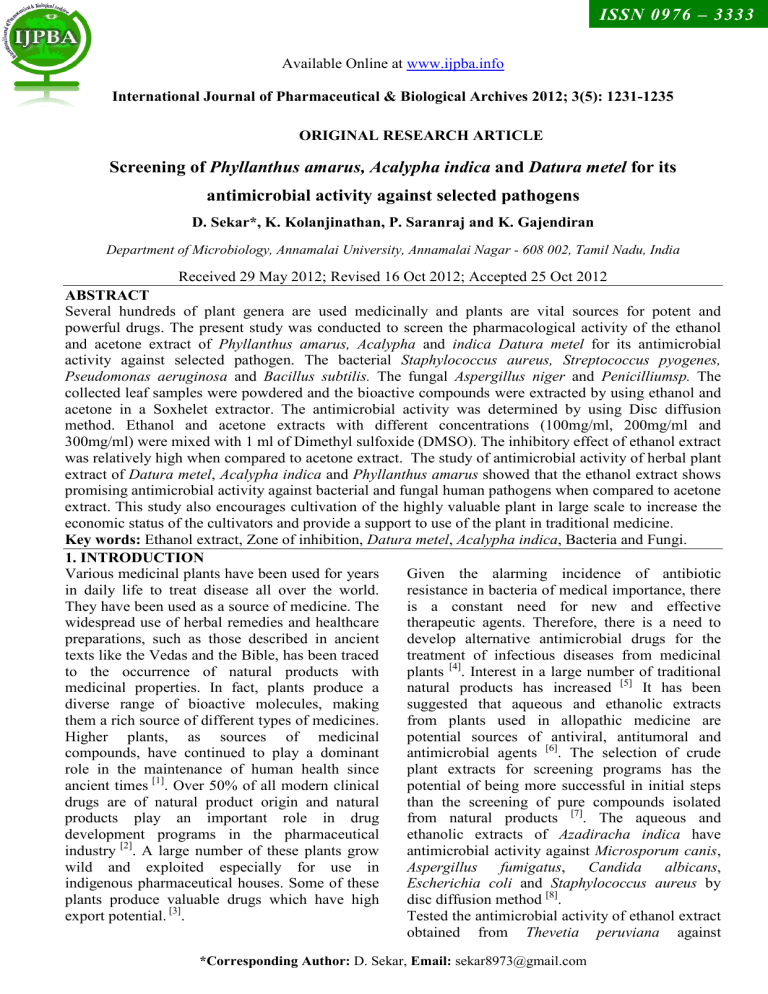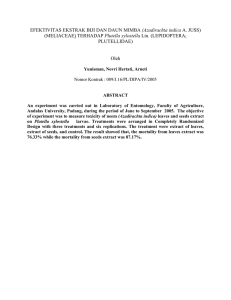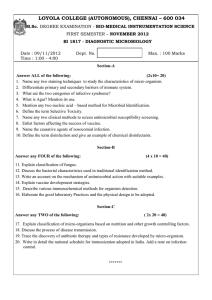
ISSN 0976 – 3333
Available Online at www.ijpba.info
International Journal of Pharmaceutical & Biological Archives 2012; 3(5): 1231-1235
ORIGINAL RESEARCH ARTICLE
Screening of Phyllanthus amarus, Acalypha indica and Datura metel for its
antimicrobial activity against selected pathogens
D. Sekar*, K. Kolanjinathan, P. Saranraj and K. Gajendiran
Department of Microbiology, Annamalai University, Annamalai Nagar - 608 002, Tamil Nadu, India
Received 29 May 2012; Revised 16 Oct 2012; Accepted 25 Oct 2012
ABSTRACT
Several hundreds of plant genera are used medicinally and plants are vital sources for potent and
powerful drugs. The present study was conducted to screen the pharmacological activity of the ethanol
and acetone extract of Phyllanthus amarus, Acalypha and indica Datura metel for its antimicrobial
activity against selected pathogen. The bacterial Staphylococcus aureus, Streptococcus pyogenes,
Pseudomonas aeruginosa and Bacillus subtilis. The fungal Aspergillus niger and Penicilliumsp. The
collected leaf samples were powdered and the bioactive compounds were extracted by using ethanol and
acetone in a Soxhelet extractor. The antimicrobial activity was determined by using Disc diffusion
method. Ethanol and acetone extracts with different concentrations (100mg/ml, 200mg/ml and
300mg/ml) were mixed with 1 ml of Dimethyl sulfoxide (DMSO). The inhibitory effect of ethanol extract
was relatively high when compared to acetone extract. The study of antimicrobial activity of herbal plant
extract of Datura metel, Acalypha indica and Phyllanthus amarus showed that the ethanol extract shows
promising antimicrobial activity against bacterial and fungal human pathogens when compared to acetone
extract. This study also encourages cultivation of the highly valuable plant in large scale to increase the
economic status of the cultivators and provide a support to use of the plant in traditional medicine.
Key words: Ethanol extract, Zone of inhibition, Datura metel, Acalypha indica, Bacteria and Fungi.
1. INTRODUCTION
Various medicinal plants have been used for years
Given the alarming incidence of antibiotic
in daily life to treat disease all over the world.
resistance in bacteria of medical importance, there
They have been used as a source of medicine. The
is a constant need for new and effective
widespread use of herbal remedies and healthcare
therapeutic agents. Therefore, there is a need to
preparations, such as those described in ancient
develop alternative antimicrobial drugs for the
texts like the Vedas and the Bible, has been traced
treatment of infectious diseases from medicinal
to the occurrence of natural products with
plants [4]. Interest in a large number of traditional
medicinal properties. In fact, plants produce a
natural products has increased [5] It has been
diverse range of bioactive molecules, making
suggested that aqueous and ethanolic extracts
them a rich source of different types of medicines.
from plants used in allopathic medicine are
Higher plants, as sources of medicinal
potential sources of antiviral, antitumoral and
antimicrobial agents [6]. The selection of crude
compounds, have continued to play a dominant
role in the maintenance of human health since
plant extracts for screening programs has the
[1]
ancient times . Over 50% of all modern clinical
potential of being more successful in initial steps
drugs are of natural product origin and natural
than the screening of pure compounds isolated
products play an important role in drug
from natural products [7]. The aqueous and
development programs in the pharmaceutical
ethanolic extracts of Azadiracha indica have
[2]
industry . A large number of these plants grow
antimicrobial activity against Microsporum canis,
wild and exploited especially for use in
Aspergillus fumigatus, Candida albicans,
indigenous pharmaceutical houses. Some of these
Escherichia coli and Staphylococcus aureus by
plants produce valuable drugs which have high
disc diffusion method [8].
[3]
export potential. .
Tested the antimicrobial activity of ethanol extract
obtained from Thevetia peruviana against
*Corresponding Author: D. Sekar, Email: sekar8973@gmail.com
Sekar et al / Screening of Phyllanthus amarus, Acalypha indica and Datura metel for its antimicrobial activity against selected
pathogens
IJPBA, Sep - Oct, 2012, Vol. 3, Issue, 5
bacterial
species
of
Escherichia
coli,
Streptococcus lactis, Enterobacter aerogenes,
Alcaligenes faecalis, Pseudomonas aeruginosa,
Proteus vulgaris and fungal species of Fusarium
oxysporum, Alternaria helianthii, Curvularia
lunata, Aspergillus niger and Penicillium sp.[9].
Evaluated the antimicrobial activity of Acorus
calamus rhizome and leaf extracts obtained with
different solvents viz., petroleum ether,
chloroform, hexane and ethyl acetate. Extracts
obtained with ethyl acetate among others were
found to be highly effective [10].
The Phyllanthus genus of the family
Euphorbiaceae was first identified in Central and
Southern India in 18th century. It is commonly
called
carry
me
seed,
stone-breaker,
windbreaker,gulf leaf flower or gala of wind [11,
12]
. Acalypha indica are two closely related
species of Meliaceae. The former is popularly
known as Indian Kuppaimeni (margosa tree) or
Indian lilac, and the latter as the Persian lilac. The
plant is a small-to medium-sized deciduous tree. It
grows to a height of 5 to 15 m tall and 30 to 60 cm
in diameter. Datura metel (Family Labiatae) is a
many branched, erect, stout and aromatic herb
about 75 cms high. This small herb is found
throughout India and is cultivated, worshiped in
temples and houses of Hindus. This is commonly
known as Vishnu-Priya, Oomathai in Sanskrit,
Kala- Oomathai in Hindi and India’s Holy Basil in
English.
2. MATERIALS AND METHODS
Collection of plant materials
Healthy leaves of Phyllanthus amarus, Acalypha
indica and Datura metel were collected the Herbal
garden, Department of Microbiology, Annamalai
University, Chidambaram, Tamil Nadu. The
leaves of Acalypha indica were washed
thoroughly three times with water and once with
distilled water. The plant materials were air dried
and powdered. The powdered samples were
hermetically sealed in separate polythene bags
until the time of extraction.
Preparation of plant extract
50 g of powdered leaves of Phyllanthus amarus,
Acalypha indica and Datura metel with 200 ml of
ethanol at 56-60°C and acetone in Soxhelet
extractor until the extract was clear. The extracts
were evaporated to dryness and the resulting pasty
form extracts were stored in a refrigerator at 4°C
for future use [13].
Test microorganisms
Microorganisms chosen were obtained from the
laboratory of Department of Microbiology,
Annamalai University. The organisms used for
this study were Staphylococcus aureus,
Streptococcus
pyogenes,Pseudomonas
aeruginosa,Bacillus
subtilis,
Aspergillus
niger,Penicillium sp.
Inoculum preparation
Bacterial inoculum was prepared by inoculating a
loopful of test organisms in 5 ml of Nutrient broth
and incubated at 37°C for 3-5 hours till a
moderate turbidity was developed. The fungal
inoculum was prepared by inoculating a loopful of
test organisms in 5 ml of Sabouraud’s dextrose
broth and incubated at room temperature for 3-5
hours till a moderate turbidity was developed.
Preparation of paper disc
Disc of 5 mm diameter were pretreated using
Whatman filter paper No.1. These were sterilized
in the hot air oven at 160°C for 1 hour. The discs
were impregnated with 20µl of different solvent
extracts (Ethanol and Acetone) at different
concentration ranging from 100-300 mg/ml for the
five different seeds to check their antimicrobial
activity. Control paper discs were also prepared
by using 1% DMSO.
Determination of antibacterial activity
Disc diffusion method was adopted for evaluation
of antimicrobial activity of five different
medicinal leaves. Muller Hinton agar was
prepared and autoclaved at 15 lbs pressure for
20 minutes and cooled at 45°C. The cooled media
was poured on to sterile petriplates and allowed
for solidification. The plates with media were
seeded with the respective microbial suspension
using sterile swab. The disc impregnated with
respective leaf extract at different concentration
(100-300 mg/ml) individually were placed on the
four corners of each petridishes, control disc was
also placed. The petridishes were then incubated
at 37°C for 24 hours. After incubation period, the
diameter of the zone formed around the paper disc
were measured and expressed in mm [14].
3. RESULTS AND DISCUSSION
The beneficial medicinal effects of plant materials
typically result from the secondary products
present in the plant although, it is usually not
attributed to a single compound but a combination
of the metabolites. The medicinal actions of plants
are unique to a particular plant species or group,
consistent with the concept that the combination
of secondary products in a particular plant is
taxonomically distinct [15]. The screening of plants
1232
© 2010, IJPBA. All Rights Reserved.
IJPBA, Sep - Oct, 2012, Vol. 3, Issue, 5
Sekar et al / Screening of Phyllanthus amarus, Acalypha indica and Datura metel for its antimicrobial activity against selected
pathogens
usually involves several approach; ethno botanical
approach is one of the common methods that are
employed
in
choosing
the
plant
for
pharmacological study.
The antimicrobial activity of ethanol and acetone
extract of Phyllanthus amarus showed inhibitory
effect on a concentration of 100, 200, 300mg/ml
and the results were showed in (Table 1 & 2). The
antimicrobial activity of ethanol and acetone
extract of Azadiracha indica showed inhibitory
effect on a concentration of 100, 200, 300mg/ml
and the results were showed in (Table 3 & 4). The
antimicrobial activity of ethanol and acetone
extract of Datura metel showed inhibitory effect
on a concentration of 100, 200, 300mg/ml and the
results were showed in (Table 5 & 6).
The antimicrobial activity of Datura metel leaves
against bacteria and yeast. The diameter of
inhibition zone recorded in Escherichia coli was
18 mm for 22 μl of oil. These differences may be
attributed due to presence of antibacterial
component in high concentration in local variety
enhancing the medicinal importance of indigenous
essential oil [16]. Proposed that the aqueous and
ethanolic extracts of Azadiracha indica have
antimicrobial activity against Microsporum canis,
Aspergillus fumigatus, Candida albicans,
Escherichia coli and Staphylococcus aureus by
disc diffusion method. There was no zone of
inhibition of Acalypha indica towards Aspergillus
fumigatus and Candida albicans. The leaves and
roots of the aqueous extract of Azadiracha indica
inhibit the growth of Microsporum canis [17].
The antibacterial activity of valuable compounds
from various solvent extracts of Azadiracha
indica, Blumea lacera and Melia azadirachta
against
Escherichia
coli,
Pseudomonas
aeruginosa,
Serratia
maraceseuns
and
Staphylococcus aureus by tube diffusion method.
Acetone and methanol extracts of all plants
showed strong antibacterial effect, where as
petroleum ether and aqueous did not exhibit any
effect. Pseudomonas aeruginosa and Serratia
marcesenes were relatively more sensitive [18].
Some bacteria posses mechanism for converting
substance toxic to it into non-toxic substances.
Staphylococcus aureus and other species produce
the enzyme penicillinase, which convert penicillin
to penicillinic acid which could not inhibit its
growth. [19] Phyllanthus amarus can help control
infection caused by Staphylococcus aureus which
is a major pathogen of human infections varying
from food poisoning or minor skin infections [20]
to severe life threatening infections, such as
septicaemia [21] and disseminated abscesses in all
organs and Escherichia coli which causes Urinary
Tract Infection (UTI), diarrhea, sepsis and
meningitis.
Tested the aqueous and ethanol extracts of
Acalypha indica against Microsporum canis,
Aspergillus fumigatus, Candida albicans,
Escherichia coli and Staphylococcus aureus by
disc diffusion method. There was no zone of
inhibition of Acalypha indica towards Aspergillus
fumigatus and Candida albicans [22]. Tested the
medicinal plant extracts of Curcuma longa,
Acalypha indica, and Anona sqamosa by Cold
percolation method against Dermatophytic
isolates. Curcuma lounga showed antifungal
effect against Trichophyton rubrum and
Microsporum gypseum. These two organisms
were found to be resistant towards Acalypha
indica and Anona sqamosa. The other
dermatophytes were resistant to all medicinal
plants tested [23].
Table 1: Antimicrobial activity of ethanol extract of
Phyllanthus amarus
S. No
1
2
3
4
5
6
Bacteria
Staphylococcus
aureus
Streptococcus
pyogenes
Pseudomonas
aeruginosa
Bacillus subtilis
Aspergillus niger
Penicillium sp.
Concentration of the extract (mg/ml)
and zone of inhibition (mm)
Control
100
200
300
mg/ml
mg/ml
mg/ml
15mm
21mm
24mm
-
10mm
13mm
17mm
-
18mm
23mm
26mm
-
20mm
5mm
7mm
25mm
8mm
11mm
28mm
12mm
15mm
Table 2: Antimicrobial activities of acetone extract of
Phyllanthus amarus
S. No
1
2
3
4
5
6
Bacteria
Staphylococcus
aureus
Streptococcus
pyogenes
Pseudomonas
aeruginosa
Bacillus subtilis
Aspergillus
niger
Penicillium sp.
Concentration of the extract (mg/ml) and
zone of inhibition (mm)
Control
100
200
300
mg/ml
mg/ml
mg/ml
12mm
18mm
21mm
-
7mm
10mm
14mm
-
15mm
20mm
23mm
-
17mm
2mm
22mm
5mm
26mm
9mm
-
4mm
8mm
12mm
Table 3: Antimicrobial activity of ethanol extract of Acalypha
indica
S. No
1
2
3
4
5
6
Bacteria
Staphylococcus
aureus
Streptococcus
pyogenes
Pseudomonas
aeruginosa
Bacillus subtilis
Aspergillus
niger
Penicillium sp.
Concentration of the extract (mg/ml) and
zone of inhibition (mm)
Control
100
200
300
mg/ml
mg/ml
mg/ml
10 mm
12 mm
13 mm
-
8 mm
9 mm
11mm
-
11 mm
13 mm
16 mm
-
13 mm
-
15 mm
-
18 mm
-
-
2mm
6mm
10mm
1233
© 2010, IJPBA. All Rights Reserved.
Sekar et al / Screening of Phyllanthus amarus, Acalypha indica and Datura metel for its antimicrobial activity against selected
pathogens
Table 4: Antimicrobial activity of acetone extract of Acalypha
indica
S. No
Bacteria
1
Staphylococcus
aureus
Streptococcus
pyogenes
Pseudomonas
aeruginosa
Bacillus subtilis
Aspergillus
niger
Penicillium sp.
2
3
4
5
6
Concentration of the extract (mg/ml) and
zone of inhibition (mm)
Control
100
200
300
mg/ml
mg/ml
mg/ml
-
15mm
17mm
18mm
-
-
-
-
-
9mm
12mm
15mm
-
18mm
-
22mm
-
28mm
-
-
7mm
9mm
10mm
Table 5: Antimicrobial activity of ethanol extract of Datura
metel
S. No
1
2
IJPBA, Sep - Oct, 2012, Vol. 3, Issue, 5
3
4
5
6
Bacteria
Staphylococcus
aureus
Streptococcus
pyogenes
Pseudomonas
aeruginosa
Bacillus subtilis
Aspergillus
niger
Penicillium sp.
Concentration of the extract (mg/ml) and
zone of inhibition (mm)
Control
100
mg/ml
200
mg/ml
300
mg/ml
-
7mm
10mm
16mm
-
13mm
17mm
23mm
-
10mm
15mm
21mm
-
3mm
7mm
12mm
-
-
-
-
Table 6: Antimicrobial activity of acetone extract of Datura
metel
S. No
1
2
3
4
5
6
Bacteria
Staphylococcus
aureus
Streptococcus
pyogenes
Pseudomonas
aeruginosa
Bacillus subtilis
Aspergillus
niger
Penicillium sp.
Concentration of the extract (mg/ml) and
zone of inhibition (mm)
Control
100
200
300
mg/ml
mg/ml
mg/ml
-
11mm
13mm
15mm
-
-
-
-
-
5mm
9mm
11mm
-
14mm
-
18mm
-
24mm
-
-
3mm
5mm
6mm
4. CONCLUSION
The study of antimicrobial activity of herbal plant
extract of Phyllanthus amarus, Acalypha indica
and Datura metel showed that the ethanol extract
shows promising antimicrobial activity against
bacterial and fungal human pathogens when
compared to acetone extract. The results also
indicated that scientific studies carried out on
medicinal plants having traditional claims of
effectiveness might warrant fruitful results. These
plants could serve as useful source of new
antimicrobial agents.
REFERENCES
1. Farombi, E.O. 2003. African indigenous
plants with chemotherapeutic potentials
and biotechnological approach to the
production of bioactive prophylactic
agents. African Journal of Biotechnology,
2: 662-671.
2. Baker, J.T., R.P. Borris and B. Carte.
1995. Natural product drug discovery and
development: New perspective on
international collaboration. Journal of
Natural Products, 58: 1325-1357.
3. Rathish R. Nair and Sumitra V. Chandra.
2005. Pucinia granatum - A potential
source as antibacterial drug. Asain journal
of Microbiology, Biotechnology and
Environmental Science, 7: 625 - 628.
4. Agrawal, P., V. Rai and R.B. Singh. 1996.
Randomized, placebo controlled singleblind trial of holy basil leaves in patients
with
noninsulin-dependent
Diabetes
mellitus. International Journal of Clinical
Pharmacology and Therapeutics, 34:406409.
5. Taylor, R.S.L., N.P.Manandhar and
J.B.Hudson. 1996. Antiviral activities of
Nepalese
medicinal
plants.
J
Ethnopharmacol., 52:157-163.
6. Chung, T.H, J.C. Kim and M.K.
Kim.1995. Investigation of Korean plant
extracts for potential phytotherapeutic
agents
against
B-virus
Hepatitis.
Phytotherapy Res., 9: 429-434.
7. Kusumoto, I.T, T. Nakabayashi and H.
Kida. 1995. Screening of various plant
extracts used in ayurvedic medicine for
inhibitory
effects
on
Human
immunodeficiency virus type 1 (HIV-1)
protease. Phytotherapy Res., 9: 180-184.
8. Ali Rehman, Latif and Adam. 2002.
Antimicrobial activity of leaf extract of
Acalypha indica. Journal of India
medicinal plant, 1: 503- 508.
9. Ravikumar Patil, H. S., H.K. Makari and
H.
Gurumurthy.
2007.
Invitro
antimicrobial activity of ethanol extract of
Thevetia peruviana, EJEAF Che., 6 (9):
2318-2322.
10. Asha Devi and Deepak Ganjewala. 2009.
Antimicrobial activity of Acorus calamus
rhizome and leaf extract. Acta Biologica
Szegediensis, 53 (1): 45-49.
11. Bharatiya, V.B. 1992. Selected Medicinal
Plants of India. Tafa Press, Bombay, pp:
235-237.
12. Joseph, B. and S.J. Raj. 2010.
Phytopharmacological and phytochemical
1234
© 2010, IJPBA. All Rights Reserved.
IJPBA, Sep - Oct, 2012, Vol. 3, Issue, 5
Sekar et al / Screening of Phyllanthus amarus, Acalypha indica and Datura metel for its antimicrobial activity against selected
pathogens
properties of Ficus species: An overview.
Int. J. Pharma. Biosci., 1: 246-253.
13. Chessbrough, M. 2000. Medical laboratory
manual for Tropical countries, Linacre
House, Jordan Hill, Oxford.
14. Garg, SC and RK. Jain, 1998.
Antimicrobial efficacy of essential oil
from Curcuma caesia. J. Phytoche. 38
167-170.
15. Parekh, J., D. Jadeja , S. Chanda. 2005.
Efficacy of Aqueous and Methanol
Extracts of Some Medicinal Plants for
Potential Antibacterial Activity. Turkey
Journal of Biology, 29: 203-210.
16. Cock, I.E. 2008. Antimicrobial Activity of
Aloe barbadensis miller leaf gel
components, J. Microbiol., 4: 2.
17. Ali Rehman, Latif and Adam. 2002.
Antimicrobial activity of leaf extract of
Acalypha indica. Journal of India
medicinal plant, 1: 503- 508.
18. Ramasamy and Charles Manoharan. 2004.
Antibacterial effect of volatile components
of selected medicinal plants against human
pathogens. Asian journal of Microbiology,
Biotechnology and environmental science,
6: 209-210.
19. Singleton, P. 1999. Bacteria in Biology,
Biotechnology and medicine (4th edition)
John Wiley and sons Ltd. New
20. Adebayo-tayo, B.C. and Adegoke, A. A.
2008. Phytochemical and microbial
screening of herbal remedies in Akwa
Ibom State, South Southern Nigeria.
Journal of Medicinal Plants Research.
2(11): 306-310.
21. Komolafe, A. O. and Adegoke, A. A.
2008. Incidence of bacterial septicaemia in
Ile-Ife Metropolis, Nigeria. Malaysian
Journal of Microbiology, 4(2): 51- 61.
22. Ali Rehman, Latif and Adam. 2002.
Antimicrobial activity of leaf extract of
Acalypha indica. Journal of India
medicinal plant, 1: 503- 508.
23. Anand,
R.,
Murugan,
S
and
Bhuvaneshwari, K. 2007. Effect of three
plant extracts on six Dermatophytic
isolates from human clinical cases. Asian
Journal of Microbiology, Biotechnology
and Environmental science, 9: 273 – 276.
1235
© 2010, IJPBA. All Rights Reserved.





